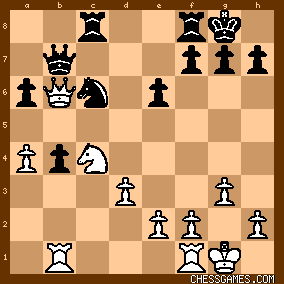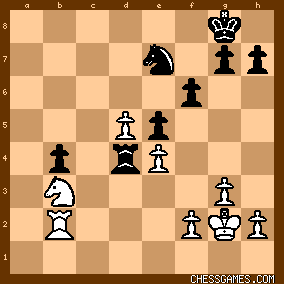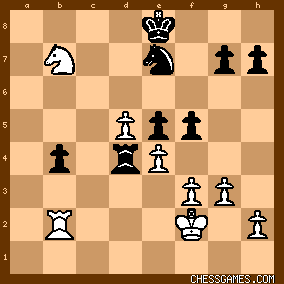| Tomlinsky: 21…Nd7 22 Bd4 b4 23 Nc4 Nb8 24 Qe5 Bf6 25 Qe3 Bxd4 26 Qxd4 Nc6 27 Qb6 See next note.

click for larger view27…Qd7 28 Rb2 Nd4 29 Re1 Rb8 30 Qxa6 Ra8 31 Qd6
Getting rid of the queens in order to carry out the strategic plan with a little interference as possible. 
click for larger view31…Qxd6 32 Nxd6 Rxa4 33 Kg2 Rd8 34 Rc1 Raa8 35 Nc4 Rab8 36 e3 Nf5 37 Ne5 Ne7 38 Rc7 Re8 39 Rc4 f6 40 Nd7
Rbd8 41 Nc5 Nc6 42 d4

click for larger view42…e5
Forced because White threatened both Na6 and Nd3.
43 Nb3 Rc8 44 d5 Ne7 45 Rxc8 Rxc8 46 e4 Rc4 47 Nd2 Rd4 48 Nb3 The repeating of moves: nothing to lose and Black might just succumb immediately with 48…Rxe4 49 d6 Nc6 50 Rc2. 
click for larger view48…Rc4 49 f3 Kf7 50 Na5 Rd4 51 Kf2 Ke8 52 Nb7 f5
Weakens the e-pawn, but otherwise Nc5-a6 or e6 follows. It is unnerving how often the winner ends up with connected passed pawns on the e- and d-files in games like this. 
click for larger view53 Ke3 Nc8 54 Rc2 Nb6 55 Rc6 Na4 56 Nd6+ Kd7 57 Nc4 b3 58 Nxe5+ Kd8 59 Rc1 
click for larger view1-0
Care must be taken when playing such a game, as if Black had been able to keith and gazzaobtain the initiative then suddenly his possession of a passed pawn could have been lethal. It gives me tremendous pleasure each time I play through a game as smooth and logical as this, especially when I think of the mess Radulov would love to have created! Keith Arkell - Kingpin (Summer 1989) | 




































